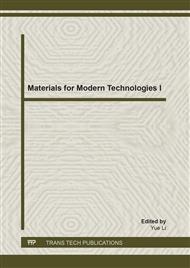[1]
Cho. J, Wang. C, Chan. H, Rickman. J, Harmer. M. Role of segregating dopants on the improved creep resistance of aluminum oxide. Acta. mater. 1999 (47) 4197-207.
DOI: 10.1016/s1359-6454(99)00278-5
Google Scholar
[2]
Takigawa. Y, Ikuhara. Y, Sakuma. T. Grain boundary bonding state and fracture energy in small amount of oxide-doped fine-grained Al2O3. J. Mater. Sci. 1999 (34) 1991-7.
Google Scholar
[3]
French. J D, Zhao. J, Harmer. M P, Chan. H M, Miller. G A. Creep of duplex microstructures. J. Am. Ceram. Soc. 1994 (77) 2857-65.
Google Scholar
[4]
Cho. J, Harmer M P, Chan H M, Rickman J M, Thompson A M. Effect of yttrium and lanthanum on the tensile creep behavior of aluminum oxide. J. Am. Ceram. Soc. 1997 (80) 1013-7.
DOI: 10.1111/j.1151-2916.1997.tb02936.x
Google Scholar
[5]
Li. Y Z, Wang. C, Chan. H M, Rickman. J M, Harmer. M P, Chabala. J M et al. Codoping of alumina to enhance creep resistance. J. Am. Ceram. Soc. 1999 (82) 1497-504.
DOI: 10.1111/j.1151-2916.1999.tb01947.x
Google Scholar
[6]
West. G, Perkins. J, Lewis. M. The effect of rare earth dopants on grain boundary cohesion in alumina. J. Eur. Ceram. Soc. 2007 (27) 1913-8.
DOI: 10.1016/j.jeurceramsoc.2006.07.001
Google Scholar
[7]
Krefetz. S B, Fischer. T E. Wear of yttria-doped α-alumina: effects of grain-boundary composition and machine stiffness. Wear. 1997 (211) 141–145.
DOI: 10.1016/s0043-1648(97)00063-x
Google Scholar
[8]
Moya. E, Moya. F, Lesage. B, Loudjani. M, Grattepain. C. Yttrium diffusion in α-alumina single crystal. J. Eur. Ceram. Soc. 1998 (18) 591-4.
DOI: 10.1016/s0955-2219(97)00170-2
Google Scholar
[9]
Dogan. C P, Hawk. J A. Effect of grain boundary glass composition and devitrification on the abrasive wear of Al2O3. Wear. 1995 (181-183) 129-137.
DOI: 10.1016/0043-1648(94)07008-3
Google Scholar
[10]
Goswami. A P, Roy S, Mitra. M, Das. G C. Influence of powder, chemistry and microstructure on the wear resistance of liquid-phase-sintered Al2O3. Wear. 2000 (244) 1-14.
DOI: 10.1016/s0043-1648(00)00407-5
Google Scholar
[11]
Dickey. E C, Frazer. C S, Watkins. T R, Hubbard. C R. J. Eur. Ceram. Soc. 1999 (19) 2503-2509.
Google Scholar
[12]
Xiong. Y, Wu. B L. Preparation of the system of MgO-CaO-SiO2-Al2O3-Y2O3 wear-resistant alumina ceramics. Adv Mater Res. 2014 (941-944) 542-546.
Google Scholar


